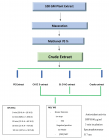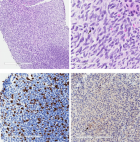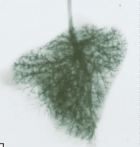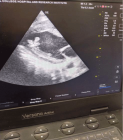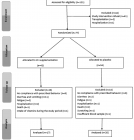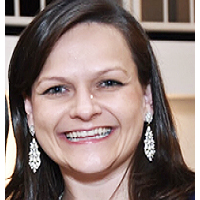Abstract
Research Article
Endovascular treatment of complex cerebral arterial saccular aneurysms with different methods of coiling: 14 years of experience review
Dmytro V Scheglov*, Stanislav V Konotopchik, Maryna Y Mamonova and Oleg E Sviridyuk
Published: 21 June, 2017 | Volume 1 - Issue 1 | Pages: 005-019
The Objective: to improve the treatment results for patients with cerebral arterial saccular aneurysms by optimizing of differentiated approach to the using of endovascular assisting occlusion techniques.
Materials and Methods: The work is based on the comprehensive survey and treatment of 1345 patients with cerebral saccular arterial aneurysms (AA), who were treated at the SO “Scientific-Practical Center of endovascular neuroradiology of NAMS of Ukraine” from 2002 to 2016. 214 cases were selected for further clinical-instrumental dynamic observation in follow-up period. All patients were operated by endovascular approach in “before hemorrhage” period, in acute or “cold” period of the disease on for symptomatic or asymptomatic intracranial saccular AA in both vascular pools with balloon-remodeling or stent-assisting techniques using with the coiling or just detachable coils (DC) using-mono-coils occlusion technique. Depending on the initial endovascular occlusion method, the patients were divided into three groups for observation: I group (mono-coils occlusion)-82 (38.3%) patients, II group (balloon-remodeling technique using)-68 (31.8%) patients, group III (stent-assisting technique occlusion)-64 (29.9%) patients. The life quality and the level of social adaptation were evaluated before hospital discharge and at the follow-up control examinations by Glasgow Outcome Scale (GOS) and by the modified Rankine scale (mRS). AA radicalism occlusion was assessed by Modified Raymond-Roy Scale (MRRS) (Mascitelli JR, et al., 2015). AA occlusion I and II by MRRS was considered as “Effective”.
Results: 9 criteria of cerebral saccular AA complexity inherent in endovascular surgery have been developed based on the technical and surgical features of endovascular methods of the cerebral AA occlusion and X-ray-anatomical characteristics of aneurysms, which complicated the “effective” reconstructive occlusion of AA cavity.
The evaluation of the AA complexity criteria prognostic significance to achieve the “effective” primary occlusion, shown different results in different groups: high prognostic significance of 4 criteria was shown in group I, of 2 criteria - in group III, and no any criteria significance in group II.
There was no statistically significant difference between groups in the primary AA occlusion efficacy and initial good results by GOS and mRS.
It was proved that endovascular occlusion of complex cerebral AA with the assisting methods using has high efficiency in all periods of the disease, unlike the method of mono-coils occlusion, which is most effective in acute and “cold” periods.
There was no statistically significant difference between the number of intraoperative, postoperative and non-surgical complications (p>0.05).
It was found that all methods of complex AA endovascular occlusion can effectively prevent the disease recurrence despite the differences between them in the stability of the AA cavity occlusion.
Conclusions: Consideration of developed AA complexity criteria during endovascular surgery planning allows to choose the most optimal and safe individual method of primary or phased AA occlusion and helps to reduce the frequency of AA recanalization in follow-up period. The choice of the complex AA occlusion method doesn’t effect on result of primary treatment, the number of intraoperative complications and the quality of primary occlusion. However, an analysis of the long-term treatment results indicates that the assisting techniques have proven advantages according to the occlusion stability.
Read Full Article HTML DOI: 10.29328/journal.hacr.1001002 Cite this Article Read Full Article PDF
Keywords:
Complexity cerebral arterial aneurysm; Aneurysm complexity criteria; Endovascular occlusion; Assisting methods; Radicalism of occlusion; Recanalization
References
- Krylov VV, Godkov DV. Cerebral aneurysm surgery. Editor Krylov VV, Moscow, Novoe Vremya. 2011; 1: 12-15.
- Choudhri O, Mukerji N. Combined endovascular and microsurgical management of complex cerebral aneurysms. Front Neurol. 2013; 4: 108-115. Ref.: https://goo.gl/T1xHdR
- Byrne JV, Guglielmi G. Endovascular treatment of intracranial aneurysms. 1998; 248. Ref.: https://goo.gl/6c16Yc
- Shchehlov DV. Diagnostics and endovascular treatment of intracranial arterial aneurysms: author's abstract. Dis. For Dr. Med. Sciences. Neurosurgery, Kyiv, 2014; 13-27.
- Kandyba DV, Babichev KN, Savello AV. The role of assisting methods for intravascular occlusion of cerebral aneurysm. Circul Pathol Cardiac Surg. 2012; 3: 27-34.
- Hacein-Bey L, Connolly ES Jr, Mayer SA, Young WL, Pile-Spellman J, et al. Complex intracranial aneurysms: combined operative and endovascular approaches. Neurosurgery. 1998; 43: 1304-1312. Ref.: https://goo.gl/8LZ1BA
- Fandino J, Taussky P, Marbacher S, Muroi C, Diepers M, et al. The concept of a hybrid operating room: applications in cerebrovascular surgery. Acta Neurochir Suppl. 2013; 115: 113-117. Ref.: https://goo.gl/R2NvTJ
- Murayama Y, Arakawa H, Ishibashi T, Kawamura D, Ebara M, et al. Combined surgical and endovascular treatment of complex cerebrovascular diseases in the hybrid operating room. J Neurointerv Surg. 2013; 1: 489-493. Ref.: https://goo.gl/hUCy4N
- Piotin M, Blanc R. Balloons and stents in the endovascular treatment of cerebral aneurysms: vascular anatomy remodeled. Front Neurol. 2014; 5: 41-50. Ref.: https://goo.gl/zE96NL
- Hanel RA, Spetzler RF. Surgical treatment of complex intracranial aneurysms. Neurosurgery. 2008; 62: 1289-1299. Ref.: https://goo.gl/uyhkqq
- Andaluz N, Zuccarello M. Treatment strategies for complex intracranial aneurysms: review of a 12-year experience university of cincinnati. Skull Base. 2011; 21: 233-242. Ref.: https://goo.gl/31KVJh
- Chitale R, Chalouhi N, Theofanis T, Starke RM, Amenta P, et al. Treatment of ruptured intracranial aneurysms: comparison of stenting and balloon remodeling. Neurosurgery. 2013; 72: 953-959. Ref.: https://goo.gl/cNypTX
- Raymond J, Guilbert F, Weill A, Georganos SA, Juravsky L, et al. Long-term angiographic recurrences after selective endovascular treatment of aneurysms with detachable coils. Stroke. 2003; 34: 1398-1403. Ref.: https://goo.gl/2KfkZC
- Roach MR. A model study of why some intracranial aneurysms thrombose but others rupture. Stroke. 1978; 9: 583-587. Ref.: https://goo.gl/ma4BMe
- Smith RL, Blick EF, Coalson J, Stein PD. Thrombus production by turbulence. J Appl Physiol. 1972; 32: 261-264. Ref.: https://goo.gl/WEG5pS
- Guglielmi G, Vinuela F, Dion J, Duckwiler G. Electrothrombosis of saccular aneurysms via endovascular approach. Part 2: Preliminary clinical experience. J Neurosurg. 1991; 75: 8-14. Ref.: https://goo.gl/PGuXkD
- Moret J, Cognard C, Weill A, Castaings L, Rey A. Reconstruction technic in the treatment of wide-neck intracranial aneurysms. Long-term angiographic and clinical results. Apropos of 56 cases. J Neuroradiol. 1997; 24: 30-44. Ref.: https://goo.gl/ztpZ9X
- Van Rooij WJ, Sluzewski M, Metz NH, Nijssen PC, Wijnalda D, et al. Carotid balloon occlusion for large and giant aneurysms: evaluation of a new test occlusion protocol. Neurosurgery. 2000; 47: 116-121. Ref.: https://goo.gl/43PyMZ
- Shcheglov VI. Endovascular occlusion of saccular intracranial aneurysms: Results in 617 patients, 27th Annual Meeting of the American Society of Neuroradiology, Orlando, Florida, March 1989.
- Fox AJ, Vinuela F, Pelz DM, Peerless SJ, Ferguson GG, et al. Use of detachable balloons for proximal artery occlusion in the treatment of unclippable cerebral aneurysms. J Neurosurg. 1987; 66: 40-46. Ref.: https://goo.gl/cmPQJj
- Fiorella D, Albuquerque FC, Masaryk TJ, Rasmussen PA, McDougall CG. Balloon-in-stent technique for the constructive endovascular treatment of ultra wide-necked circumferential aneurysms. Neurosurgery. 2005; 57: 1218-1227. Ref.: https://goo.gl/nPiQ6q
- Raymond J, Guilbert F, Roy D. Neck-bridge device for endovascular treatment of wide-neck bifurcation aneurysms: initial experience. Radiology. 2001; 221: 318-326. Ref.: https://goo.gl/agbEc5
- Guglielmi G, Vinuela F, Sepetka I, Macellari V. Electrothrombosis of saccular aneurysms via endovascular approach. Part 1: Electrochemical basis, technique, and experimental results. J Neurosurg. 1991; 75: 1-7. Ref.: https://goo.gl/56A1g7
- Kim M, Levy EI, Meng H, Hopkins LN. Quantification of hemodynamic changes induced by virtual placement of multiple stents across a wide-necked basilar trunk aneurysm. Neurosurgery. 2007; 61: 1305-1313. Ref.: https://goo.gl/sWd4hj
Figures:

Figure 1

Figure 2

Figure 3

Figure 4

Figure 5

Figure 6

Figure 7

Figure 8

Figure 9
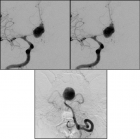
Figure 10
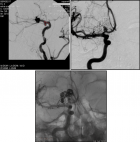
Figure 11
Similar Articles
-
Endovascular treatment of complex cerebral arterial saccular aneurysms with different methods of coiling: 14 years of experience reviewDmytro V Scheglov*,Stanislav V Konotopchik,Maryna Y Mamonova,Oleg E Sviridyuk. Endovascular treatment of complex cerebral arterial saccular aneurysms with different methods of coiling: 14 years of experience review. . 2017 doi: 10.29328/journal.hacr.1001002; 1: 005-019
Recently Viewed
-
Budesonide – Oral Galenic Formulations for Crohn DiseaseLuisetto M, Mashori GR, Cabianca L, Latyshev OYU. Budesonide – Oral Galenic Formulations for Crohn Disease. Ann Clin Gastroenterol Hepatol. 2024: doi: 10.29328/journal.acgh.1001048; 8: 028-033
-
Effectiveness of an Ayurvedic Gel for Tooth Pain Relief Due to Dental Caries: A Randomized Controlled TrialNandlal Bhojraj*, Prem K Sreenivasan, Paras Mull Gehlot, Vinutha Manjunath, Manjunath MK. Effectiveness of an Ayurvedic Gel for Tooth Pain Relief Due to Dental Caries: A Randomized Controlled Trial. J Clin Adv Dent. 2024: doi: 10.29328/journal.jcad.1001041; 8: 013-019
-
Procedure for Determining Root Canal Length in Endodontics: A Mathematical ApproachDott Edward Shahine*. Procedure for Determining Root Canal Length in Endodontics: A Mathematical Approach. J Clin Adv Dent. 2024: doi: 10.29328/journal.jcad.1001042; 8: 020-023
-
The Need of Wider and Deeper Skin Biopsy in Verrucous Carcinoma of the SoleLuca Damiani*,Giuseppe Argenziano,Andrea Ronchi,Francesca Pagliuca,Emma Carraturo,Vincenzo Piccolo,Gabriella Brancaccio. The Need of Wider and Deeper Skin Biopsy in Verrucous Carcinoma of the Sole. Ann Dermatol Res. 2025: doi: 10.29328/journal.adr.1001036; 9: 005-007
-
Development of Latent Fingerprints Using Food Coloring AgentsKallu Venkatesh,Atul Kumar Dubey,Bhawna Sharma. Development of Latent Fingerprints Using Food Coloring Agents. J Forensic Sci Res. 2024: doi: 10.29328/journal.jfsr.1001070; 8: 104-107
Most Viewed
-
Evaluation of Biostimulants Based on Recovered Protein Hydrolysates from Animal By-products as Plant Growth EnhancersH Pérez-Aguilar*, M Lacruz-Asaro, F Arán-Ais. Evaluation of Biostimulants Based on Recovered Protein Hydrolysates from Animal By-products as Plant Growth Enhancers. J Plant Sci Phytopathol. 2023 doi: 10.29328/journal.jpsp.1001104; 7: 042-047
-
Sinonasal Myxoma Extending into the Orbit in a 4-Year Old: A Case PresentationJulian A Purrinos*, Ramzi Younis. Sinonasal Myxoma Extending into the Orbit in a 4-Year Old: A Case Presentation. Arch Case Rep. 2024 doi: 10.29328/journal.acr.1001099; 8: 075-077
-
Feasibility study of magnetic sensing for detecting single-neuron action potentialsDenis Tonini,Kai Wu,Renata Saha,Jian-Ping Wang*. Feasibility study of magnetic sensing for detecting single-neuron action potentials. Ann Biomed Sci Eng. 2022 doi: 10.29328/journal.abse.1001018; 6: 019-029
-
Pediatric Dysgerminoma: Unveiling a Rare Ovarian TumorFaten Limaiem*, Khalil Saffar, Ahmed Halouani. Pediatric Dysgerminoma: Unveiling a Rare Ovarian Tumor. Arch Case Rep. 2024 doi: 10.29328/journal.acr.1001087; 8: 010-013
-
Physical activity can change the physiological and psychological circumstances during COVID-19 pandemic: A narrative reviewKhashayar Maroufi*. Physical activity can change the physiological and psychological circumstances during COVID-19 pandemic: A narrative review. J Sports Med Ther. 2021 doi: 10.29328/journal.jsmt.1001051; 6: 001-007

HSPI: We're glad you're here. Please click "create a new Query" if you are a new visitor to our website and need further information from us.
If you are already a member of our network and need to keep track of any developments regarding a question you have already submitted, click "take me to my Query."







